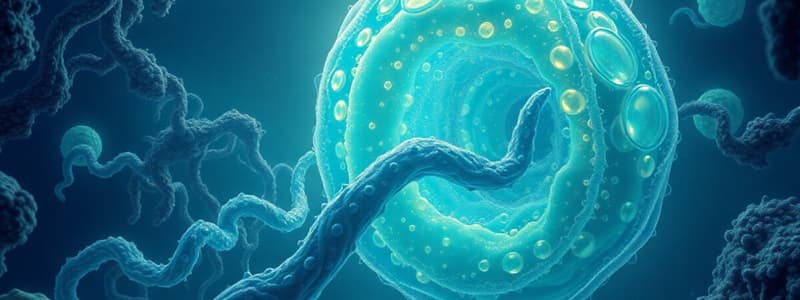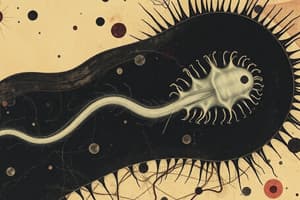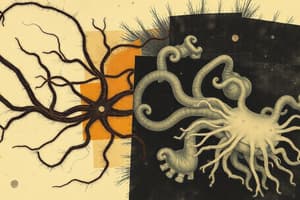Podcast
Questions and Answers
What method is primarily used by Amoebozoa for food capture?
What method is primarily used by Amoebozoa for food capture?
- Tentacles
- Pseudopodia (correct)
- Flagella
- Cilia
Entamoeba histolytica has a contractile vacuole.
Entamoeba histolytica has a contractile vacuole.
False (B)
What is the primary causative agent of amoebic dysentery?
What is the primary causative agent of amoebic dysentery?
Entamoeba histolytica
The life cycle of Entamoeba histolytica includes the trophozoite and __________ stages.
The life cycle of Entamoeba histolytica includes the trophozoite and __________ stages.
Match the following Entamoeba species with their characteristics:
Match the following Entamoeba species with their characteristics:
Which factor contributes to the virulence of Entamoeba histolytica?
Which factor contributes to the virulence of Entamoeba histolytica?
Most individuals infected with E.histolytica express disease symptoms.
Most individuals infected with E.histolytica express disease symptoms.
What type of environment facilitates the transmission of Entamoeba histolytica?
What type of environment facilitates the transmission of Entamoeba histolytica?
What is the primary mode of transmission for Entamoeba histolytica?
What is the primary mode of transmission for Entamoeba histolytica?
All infected individuals show severe symptoms of amoebic dysentery.
All infected individuals show severe symptoms of amoebic dysentery.
Name one antibiotic used to treat amoebic dysentery.
Name one antibiotic used to treat amoebic dysentery.
Entamoeba histolytica can cause secondary extraintestinal infections that typically occur in the __________.
Entamoeba histolytica can cause secondary extraintestinal infections that typically occur in the __________.
Match the following terms related to Entamoeba histolytica with their correct descriptions:
Match the following terms related to Entamoeba histolytica with their correct descriptions:
What type of ulcers are formed by the invasive strains of E. histolytica?
What type of ulcers are formed by the invasive strains of E. histolytica?
Entamoeba histolytica can invade epithelial cells lining the intestine.
Entamoeba histolytica can invade epithelial cells lining the intestine.
What is the result of the necrosis caused by E. histolytica in the intestines?
What is the result of the necrosis caused by E. histolytica in the intestines?
A virulent strain of E. histolytica can cause __________ colitis.
A virulent strain of E. histolytica can cause __________ colitis.
Which of the following is NOT a factor in determining the virulence of E. histolytica?
Which of the following is NOT a factor in determining the virulence of E. histolytica?
E. histolytica can only cause intestinal infections.
E. histolytica can only cause intestinal infections.
What is the significance of the Gal/GalNAc lectin in E. histolytica's pathogenesis?
What is the significance of the Gal/GalNAc lectin in E. histolytica's pathogenesis?
The condition where multiple large ulcers coalesce in the intestine is referred to as __________.
The condition where multiple large ulcers coalesce in the intestine is referred to as __________.
What can happen after the ulcers caused by E. histolytica heal?
What can happen after the ulcers caused by E. histolytica heal?
Flashcards are hidden until you start studying
Study Notes
Amoebozoa Lineage
- Amoebas are heterotrophic organisms found in freshwater, saltwater, and soil.
- They capture food and move by extending pseudopodia.
- They reproduce asexually via mitotic fission.
- Some amoebas are parasitic and infect humans and other primates.
Entamoeba Genus
- Entamoeba histolytica is the causative agent of amoebic dysentery.
- Amoebic dysentery is characterized by bloody and mucous diarrhea.
- It can also cause abdominal pain, fever, cramping, and weight loss.
- E. histolytica is estimated to cause 50 million cases and 40,000-100,000 deaths annually.
- Only 10-20% of E. histolytica infections result in disease.
- E. histolytica pathogenesis is influenced by parasite virulence factors, host genetics, intestinal microbiota, and immune responses.
- E. histolytica is commonly found in areas with large populations living in unsanitary conditions.
Entamoeba Histolytica
- E. histolytica is an obligate anaerobic organism.
- It does not have a contractile vacuole or mitochondria but has a mitosome.
- E. histolytica has a characteristic karyosome within its nucleus.
- E. histolytica cysts are resistant to environmental conditions.
- E. histolytica cysts are 10-15 µm with 4 nuclei and bar-shaped chromatoidal bodies made of ribosomes.
- E. histolytica cysts are diagnosed by microscopic examination of stool samples, but DNA sequencing is the most accurate.
Entamoeba Histolytica Life Cycle
- Entamoeba histolytica life cycle has two main stages: trophozoite and cyst.
- Trophozoites are actively growing, feeding, and reproducing stages.
- Cysts are transmission stages, resistant to environmental conditions.
- Trophozoites reproduce asexually via binary fission and differentiate into cysts.
- Transmission is through the fecal-oral route.
- Ingested cysts reach the small intestine and differentiate into trophozoites.
- Trophozoites migrate to the large intestine (colon) and multiply in the lumen.
- Trophozoites can invade the gut wall and cause amoebic dysentery.
- E. histolytica can invade other organs like the liver, lungs, and brain through the bloodstream.
- Amoebic dysentery is treated with metronidazole.
Pathogenesis Caused by E. Histolytica
- E. histolytica infection can range from asymptomatic to severe amoebic colitis or dysentery.
- Non-invasive (avirulent) strains of E. histolytica remain within the intestine and cause mild symptoms or are asymptomatic.
- Invasive (virulent) strains of E. histolytica invade epithelial cells lining the intestine and spread into underlying tissue layers.
- Invasive strains cause flask-shaped ulcers and bleeding in the intestine.
- Invasive strains can also invade other organs through the circulatory system, causing extraintestinal amebiasis.
Entamoeba Histolytica Adherence
- Adherence to host mucosal cells is mediated by a parasite Gal/GalNAc lectin.
- The parasite Gal/GalNAc lectin binds to host galactose (Gal) and N-acetyl-D-galactosamine (Gal/NAc) residues.
- Host cell glycoproteins lacking galactose residues are more resistant to cytotoxicity.
- The Gal/GalNAc lectin is a heterodimer.
- The parasite Gal/GalNAc lectin prevents complement-mediated lysis and allows adherence to the host mucosa.
E. Histolytica Pathogenesis
- Invasive strains of E. histolytica cause small areas of necrosis or ulcers, resulting in bloody and mucous diarrhea, which is called amoebic colitis.
- Trophozoites spread laterally and downwards, killing epithelial cells and resulting in characteristic flask-shaped ulcers.
- Hematophagous trophozoites replicate at high rates, expanding ulcers and causing fulminating necrotic colitis.
- Large numbers of ulcers coalesce to cause mucosal necrosis.
- Parts of the intestinal wall slough off, causing amoebic granuloma formation.
- Amoebic granulomas are often misidentified as tumors.
E. Histolytica Virulence Factors and Pathogenesis Regulation
- Non-invasive trophozoites remain on the luminal surface and ingest bacteria and cellular debris.
- Invasive trophozoites erode the mucous layer, kill enterocytes, and invade the lamina propria and submucosal layers.
- Parasite-derived enzymes break down the host extracellular matrix, leading to perforation of the muscle and serous layers, causing peritonitis.
- This can lead to infection spread through the circulatory system and extraintestinal infections.
- Virulence regulation is complex and involves parasite-derived virulence factors, host immune defense, and gut microbiota composition.
- Intestinal dysbiosis increases susceptibility to severe disease outcomes.
Studying That Suits You
Use AI to generate personalized quizzes and flashcards to suit your learning preferences.





